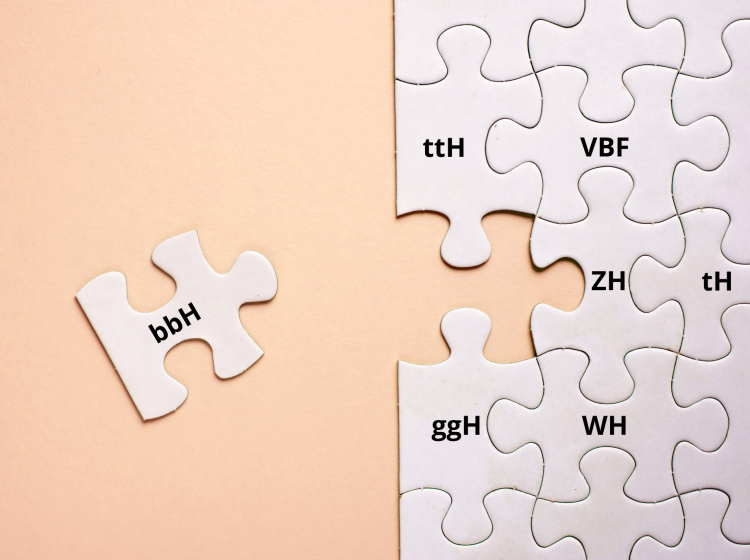
The Higgs boson was one of the biggest scientific discoveries of the last decades and opened the doors to a new era for particle physics: unveiling its mysteries and measuring its properties. We already know a lot about how the Higgs boson is generated at the LHC. In broad terms, two protons collide, some of their constituents fuse, and all that energy is converted into the Higgs boson.
CMS scientists have long worked on adding pieces to the puzzle of the Higgs boson production. First was the fusion of gluons, mediated by a loop of quarks since the Higgs doesn’t couple directly to these massless bosons. Then the fusion of vector bosons, the Z and W weak bosons to be precise, where the Higgs is left in the middle of the detector with two quarks going to the most forward regions of CMS. Sometimes the Higgs is also radiated by a particularly energetic vector boson in what we refer to as Higgs-strahlung (radiation in German). Finally, sometimes the Higgs is produced together with the heaviest fermion, the top quark. Scientists have by now discovered or found evidence for these processes, but could there be more pieces left to be added to this puzzle?
Scientists from the CMS experiment decided to find out and probe the process where the Higgs boson is produced in association with bottom quarks (bbH), a crucial yet elusive process in the realm of particle physics. The process comprises only 3% of the Higgs bosons produced at the LHC. Adding a missing piece is not easy though; we must know the shape it should have to fit into the puzzle. Two doctoral researchers, P. R. Bartschi (Zurich University) and M. Bayat Makou (DESY), together with a postdoctoral research fellow, A. Cardini (DESY), took on the challenge by studying the proton-proton collisions recorded by CMS at the LHC. A key feature of this production mechanism is how it involves different Higgs couplings: as shown in Fig. 1, there is more than one way for the Higgs to be generated together with bottom quarks, and they interfere with each other. This makes the bbH process sensitive to specific quantitative relations in the way the Higgs boson couples to various particles, which means that it is particularly interesting to see how a measurement of the bbH production probability in LHC collisions fits together with other Higgs-related processes.

Figure 1: Feynman diagrams for the H+bb production process.
Measuring the total cross section of the bbH process, σbbH, is the first step to better understand how the Higgs couplings intertwine. However, as the process is rare and challenging to identify, the available data only provides an upper limit, rather than a precise value. The analysis reports the first direct bound on σbbH to be 3.7 times the standard model (SM) expectation, as shown in Fig. 2.
.
Figure 2: Upper limits on the signal strength of the bbH process, the ratio between the measured cross section and the one expected in the SM.
This milestone not only establishes constraints on a fundamental process but also highlights the need for more precise theoretical inputs, as experimentalists chase the goal of bbH observation. The interference with the other pieces, the presence of a gluon splitting into two b-quarks, and the higher-order quantum corrections to the process, all currently limit the accuracy of theoretical predictions to about 40%. There is room for more theoretical advancements and we are looking forward to seeing some progress soon. A unique feature of this measurement is the ability to simultaneously constrain the strength and the relative sign of Higgs boson couplings to bottom and top quarks. In the SM, we expect the relative sign to be positive and a significant asymmetry would hint at new phenomena. While our current measurement shows compatibility with the SM expectations (as shown in Fig. 3), more precise measurements in the future can potentially change the picture.

Figure 3: Allowed ranges for the Higgs couplings to top quarks (Kt) and bottom quarks (Kb), according to previous measurements in red and in combination with our analysis, in green for simulation and in blue for the measurement.
While the puzzle is still unsolved, we will persist, so that one day we can finally have bbH among the known and understood production mechanisms of the Higgs boson. As our curiosity pushes us to advance, we pursue our quest to one day watch the completed puzzle and admire the patterns, symmetries, and beauty.
Read more about these results:
-
CMS Physics Analysis Summary (HIG-23-003): "Search for the SM Higgs boson produced in association with bottom quarks in final states with leptons "
-
@CMSExperiment on social media: LinkedIn - facebook - twitter - instagram
- Do you like these briefings and want to get an email notification when there is a new one? Subscribe here

